Monday 24th May 2021

Avanti West Coast’s latest wheeze to squeeze a bit more money from passengers is their new “Standard Premium” Class pitched between Standard Class and First Class. I’m guessing it ticked the box marked ‘innovations to be introduced if successful’ in the franchise bid; and from last week it became a reality.

What’s happened is one former First Class coach on Avanti’s Pendolino fleet (the one adjacent to Standard Class: ‘H’ on a 9 coach and ‘G’ on an 11 coach) has been reclassified as “Standard Premium” with new logos on the seat head rest covers.
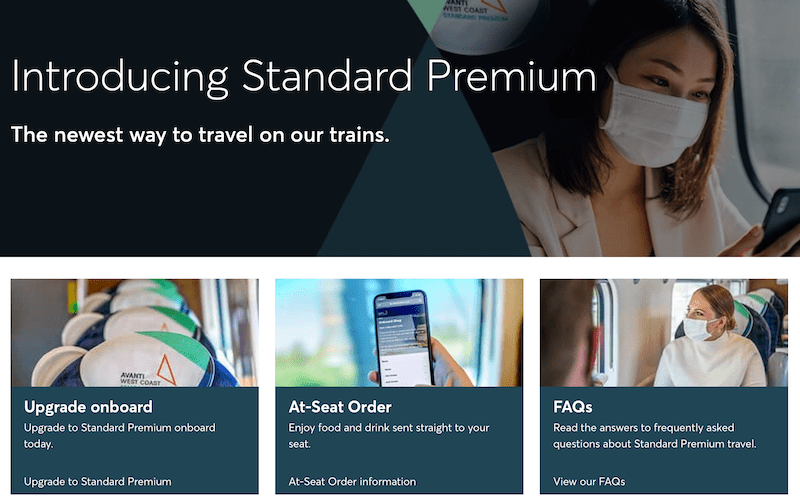
Although not on the doors leading into the coach yet. Just to add a bit of confusion.
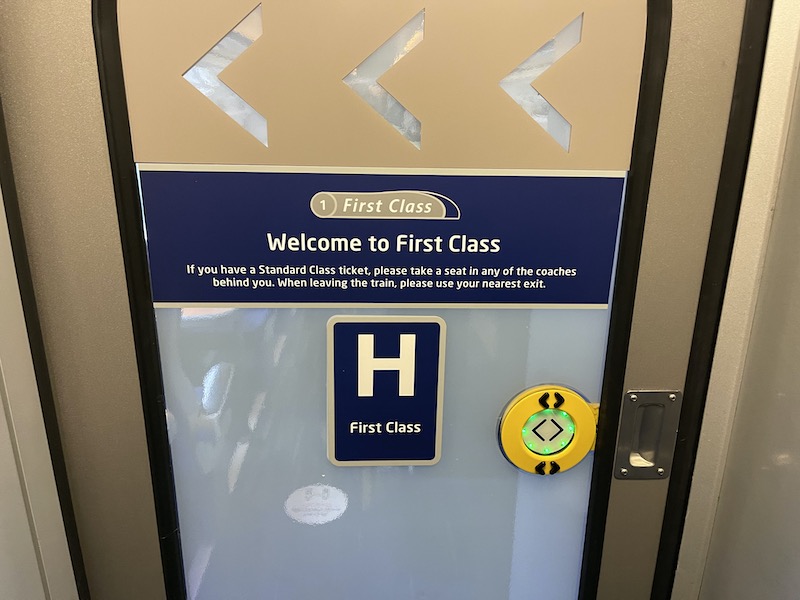
Much is made in Avanti’s online publicity and on board announcements promoting this new venture to the “roomier seats and wider tables” as well as “the freedom to order food and drink from your seat” which you can do from a Standard Class seat, as is free Wi-fi available throughout the train, despite this being badged as a “Standard Premium” benefit.

Apparently this will give “you the space to focus on what matters most”. Like what a rip-off this new venture is perhaps? Because you’ll be paying an upgrade fee for the privilege of that “roomier seat” which will most likely be a higher price than you’d pay to upgrade to First Class using the SeatFrog app and enjoy complimentary food and drink served to your seat from a trolley.
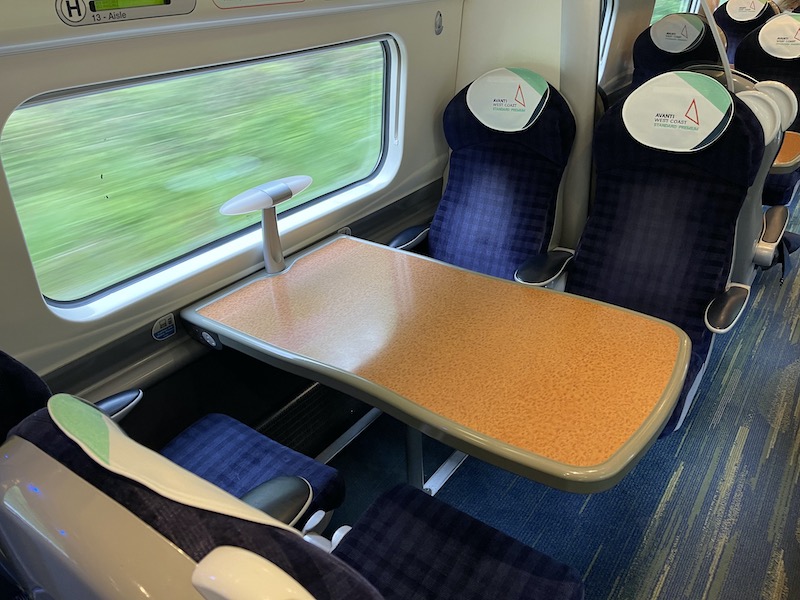
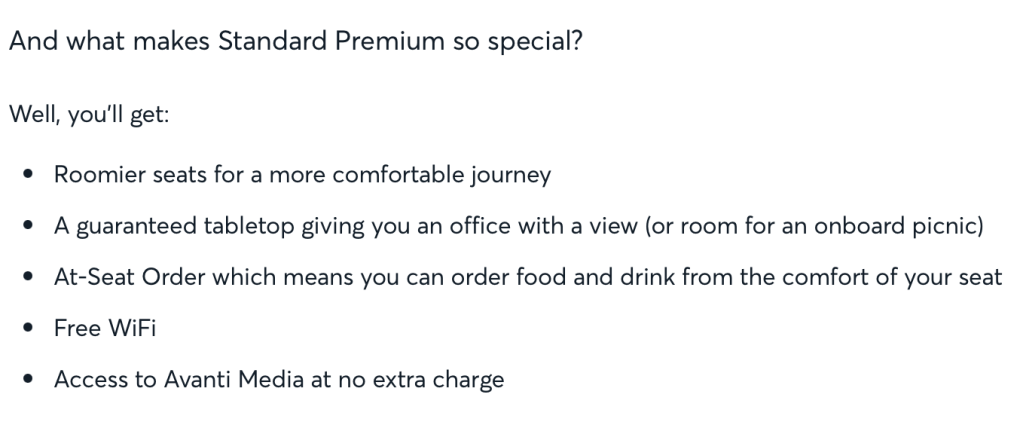
I like the “office with a view” claim … it’s a pretty small office if you’re in one of the single seats, and not much room for “an onboard picnic” if you’re sharing the table with another passenger.
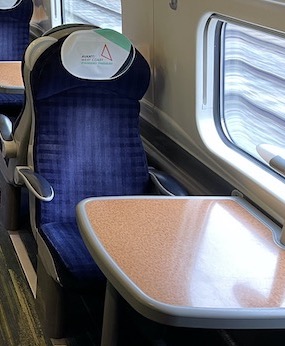
Why would you pay more for the privilege of having to pay for your tea, coffee and snacks? Standard Premium just doesn’t make any sense to me. Unless Avanti are banking on passengers not using SeatFrog. Which might be a valid thought, as I’ve written before about the dubious ethics I believe are involved in said app. I only use it with great reluctance and always find myself thinking I’m being conned each time. More on this shortly.

Back to “Standard Premium” and let’s take for an example my trip from Euston to Preston on Saturday.
The off-peak return with a Railcard is £66.40 for Standard Class.
The Standard Premium upgrade for that length of journey is £25 single each way, making £116.40 for the return.
And for that you just get the “roomier seat and wider tables” and have to pay for refreshments.

But using the SeatFrog app on Saturday I paid £21 northbound and £12 southbound to upgrade to First Class, making for a total price of £99.40 return saving £17 compared to the “Standard Premium” option.
And I got complimentary refreshments as my seat was allocated in the First Class designated coaches.

Mind you the complimentary refreshments are so poor these days. “Bacon roll or porridge” and a tea/coffee as we passed through Watford and another tea/coffee near Crewe. On the return just one tea/coffee was offered and either a packet of crisps (extra small size), a small cake or a biscuit.
If I’d booked an advanced return ticket with its associated restriction of being confined to a specific journey I could have got a Railcard single northbound for £40.25 Standard Class and £47.35 (“only 3 seats left“) First Class with the southbound journey priced at £30.45 Standard Class and £59.25 (“only 7 seats left“) First Class if I’d booked on Monday for the Saturday trip.
That makes for a non sensical more expensive and restricted to specific journeys £70.70 for the Standard Class return and £106.60 for First Class – which works out at only £35.90 more than Standard Class. If I’d used Standard Premium I’d have paid £50 more (£25 each way).
It just doesn’t make sense.
The cheapest way to travel certainly turned out to be buying a flexible off-peak Standard Return and using the SeatFrog app for a reasonably priced upgrade.
Removing one coach from First Class in every Pendolino train for Standard Premium might be justified with the number of business expense travellers now reduced with the Covid effect. Full price First Class fares are certainly out of reach for ‘ordinary’ passengers. My off-peak Preston return journey would have cost £214.60. Without a Railcard it’s even higher at £325.20. And just for the record, an Anytime Return from Euston to Preston is £514 …. what planet are these fare setters living on?

GWR and LNER have both reduced the number of First Class seats per train on their Hitachi Class 800/1/2s compared to HSTs and Mark 4 coaches so it doesn’t surprise me Avanti are trying to do something clever with a spare First Class coach in their Pendolino fleet. If it wasn’t for the expense of fitting it out, it would make more sense to fully convert it to Standard Class to provide more capacity for the majority of passengers and stop bamboozling passengers with confusing fare, ticket and upgrade offers, which despite appearances end up meaning you pay more.
I’ve noticed in recent weeks Avanti are also being quite stingy with offering poor value advance tickets as the above example shows. Certainly compared to GWR, LNER, EMR and Greater Anglia where there are some great bargains to be had.
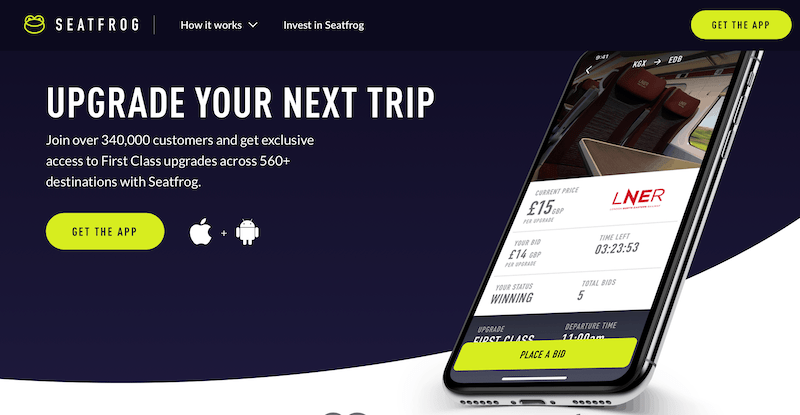
Regarding SeatFrog, my previous comments last December led to some interesting feedback from blog readers. One former employee at SeatFrog got in touch to explain some of the secrets of the algorithm this tech company uses.
He told me “a certain amount of seats are reserved only for SeatFrog in First Class”. This accords with my experience on both GWR and LNER; you always end up in the same few seats in the same coach on your upgrade. Apparently it’s about four seats per train. But the crucial thing to know is his point that “passengers are actually bidding on one seat at a time”. Again, this accords with my experience when I discovered there were two of us travelling on LNER and we both were bidding against each other only to find after the auction had closed that we had both been successful as there were at least two seats available. We needn’t have been bidding against each other after all. This really is an outrageous way to make money. And, in my view a very dubious pricing practice that needs the attention of the Competition Authority.
My correspondent advises “when the reserve is met (the bidding) hops over to the nest seat and the bidding continues. That’s why each passenger would have paid a different price with each seat getting higher and higher”.
He also alleges “the algorithm requires the winner to have bid one pound higher than the reserve”. I presume that’s to ensure there’s income for SeatFrog, as opposed to the Train Operating Company.
Another piece of interesting feedback was: “the TOC will only let those seats be bid on if First Class is no more than 40% ( I think) full. This is the most misleading trait to me. They state that it’s unsold seats. Well yes and no. They say it’s not to dilute the experience of a semi empty First Class but really it’s to get people to pay full price before letting others bid on the sweet spot in their seating model. If the capacity has been reached, the TOC will suddenly stop the bidding and kill the auction, saying you didn’t win a seat. Passengers enter the train and go to see First Class and are confused as to why the seats are empty”.
This former employee used to deal with customer feedback when he worked at SeatFrog. He told me “at the end of the day it’s a hit and miss auction because the customer is really the train company and when I tried to solve users issues and misunderstandings that had been there for years, they were ignored”.
Against that background I’m always wary when using SeatFrog; but rest assured I’m not wary about using Standard Premium. Because I won’t be using it.
It’ll be interesting to see if Great British Railways continue these rather odd and opaque arrangements with its promised one website/single app simplified approach to everything fares, pricing and ticketing.
Roger French

Avanti west Coast – wherever you’re going, we’re right there with you. To Penzance; Norwich, Dover, Weymouth … the list could go on. This is a radio advert which should really be made by the RDG or whatever as one body. It’s only at the end they (and Great Northern) introduce their own train Company.
So far as fares are concerned, scrap the lot and just make it simple. Oh this was done some years ago -just three types of fares – Anytime, Off Peak and Advance. Trouble is each of these 3 was sub-divided into hundreds of others!!
The railway is doing themselves no favours.
LikeLike
The three “types” of fares were never sub-divided; it was the other way round: the many available fares were grouped into the three bands, which are the railway’s equivalent of the airlines flexible, semi-flexible and restricted bands. “Anytime”, “Off Peak” and “Advance” are little more than marketing descriptions.
The railway’s fare system is based on that used by the airlines, but the railway has bought into the concept of open data so publish the available fares within those three bands, with websites such as BRfares allowing the public to see every available fare for any given journey – you won’t see the airlines ever publishing their fares at that level of detail!
Given that comparatively few long distance passengers buy tickets on the day of travel nowadays (even pre-Covid), a dogmatic insistence on one fare per pricing band will simply result in most passengers paying more. HM Treasury will like that, but the passengers won’t.
LikeLiked by 1 person
It’s noticeable that journey planners very much push people towards the model of single fare, fixed time. So the uninitiated may not realise there’s a cheaper flexible return. And of course the higher price and lack of flexibility may push people to just drive instead.
Also trying to work out the restrictions on a flexible return can often be a nightmare. The only easy option is often to click through all the possible times you might want to travel. It’s easier for experienced users to refer to the database on BR fares but that’s not exactly widely known or user friendly.
We can only hope that the recent changes will finally include someone having the courage to tackle the numerous problems with the current system. I’m not holding my breath though as the chance to squeeze a couple of pounds of extra revenue always seems to win out over simple & customer friendly.
LikeLike
Eurostar, RENFE and Trenitalia have all got intermediate products between Standard and First that actually work – you get a 1st Class seat and more limited free catering than in the most expensive coach. I think there is something in the concept, but Avanti haven’t got the pricing right and are trying to con people about the product!
LikeLiked by 2 people
Both Standard Premium and SeatFrog seem like rip-off scams.
SeatFrog’s practice of having customers bidding against each other for the same seat while other seats are available have guaranteed that I won’t use them – I would rather stay in Standard than support con-artists.
And £15 minimum for Standard Premium is a farce. I can see why Avanti want to do something to make better use of surplus First Class capacity but not at that price!
LikeLiked by 1 person
You were lucky to find any fares from Preston to London as last time I looked for last Saturday the message was ‘no fares available’
LikeLike
I wouldn’t pay more than £5 for a first class upgrade in these times – you get a whole double seat to yourself anyway and for me that is always enough space, as for the food, I’d much rather just get it beforehand where there’s more choice and better value.
LNER have a great offer now that if you are buying a return and say the outwards train has a cheap advance ticket but the return doesn’t, or perhaps you aren’t sure when you want to return, you can get a Super Off Peak single [online only] which is half the price of the super off peak return, meaning for that half of the journey you are paying what a super off peak single should cost considering you are returning. I am a big fan of this, and interestingly, this can be used on any valid route as long as it involves LNER, Avanti or Cross Country, although those other TOCs don’t advertise anything like this as far as I can see. However, often on the journey planner it will show this ticket as sold out on most trains even though there are plenty of seats left and the normal super off peak single is offered. Of course, since its a flexible ticket you can just book one of the trains where this ticket is available and then make a free reservation, but it seems a bit odd. It would also be nice if we could just have singles be half the price of the return (or at least somewhat close to half, this whole practice of a single being like £50.05 and the return is £50.10 is horrible)
LikeLiked by 1 person
Greater Anglia moved the other way with they new rolling stock. They have abolished first class except on the London to Norwich service
LikeLike
Not sure that it is worthwhile having first class from Sheringham to Norwich!
LikeLike
This isn’t quite a new idea some might recall that British Rail had a thing called either Silver Standard or Super Standard I can’t remember which .it was sort of a more upmarket second class but unlike this one I think that coffee and tea was free.for those who are interested the only thing that remains of this is a poster about it in the National Railway Museum in York.it was offered on 125’s but I’m not sure about 225’s and other Inter City trains.it was around the time of sectorisation and only Inter City had it.
LikeLike
Silver Standard, and it was simply the declassifying of a First Class coach but restricted to holders of full fare second class Standard [Open] tickets. I don’t recall free drinks being offered; free drinks was a privatisation-era thing.
Silver Standard applied on all long-distance IC sector routes to and from London (i.e. not Gatwick Express!), but I’m not sure if it was offered on the Cross Country routes.
LikeLiked by 1 person
Two points from me . . .
1. One of the tenets of railway privatisation was “choice” . . . give the passengers choice between value and quality. In that respect, privatisation was a huge success . . . look at the enormous increases in patronage since 1995; not all down to increased mobility within society.
2. One of the tenets of “GBR” seems to me to be the removal of “choice” . . . at least with regard to fares, with “simplification” being the latest buzzword. Simplification must mean the removal of choice . . . there’s no other way to look at it (or, if there is, then I’m all agog!!). Will simplification also mean the closure of “open access?” I’m still doubtful that the FirstRail London-Edinburgh service will ever start . . . no track capacity and revenue abstraction from GBR (aka the Treasury).
Be careful what you wish for!!
LikeLike
Usage of the Railways though has not really changed much. In 1947 there was about 12.2B journeys a year but the population was only about 39M . In 2017 the number of journeys was about 1.7B so but the population as about 67M so as a percentage per person usage of rail has actually fallen. In 1947 as well there were fewer trains simply because they were a lot slower
LikeLike
I am certain that there was more track and a greater number of routes in 1947. There was also a huge amount of troop traffic – weekend passes and all that. Not all was covered by motor coaches. I am not convinced by your 2017 figure. There may be a digit missing or a decimal point that should not be there. If there isn’t an error it is one heck of a reduction.
LikeLike
From the “metadyne” website (the late Mike Horne, whose reputation for accuracy is second to none) . . .
Total Passenger numbers in these years: 1955; 1965; 1975; 1985; 1995; 2005; 2015 . . .
994m; 865m; 730m; 686m; 719m; 1077m; 1718m.
The metadyne statistics show 1107m for 1947 (so Bob has overstated, but not by much . . . although his decimal point for 1947 seems to be incorrectly placed!).
For what it is worth, the uk.gov figures for total UK populations are (for the same 1955-2015 points as above):
51.0m; 54.2m; 56.1m; 56.4m; 56.9m; 60.2m; 65.8m.
So an increase of c15m in population, but c17m in rail journeys. However, the “headline” is actually a better than doubling of passenger journeys in the first 20 years of privatisation.
I’m no statistician, but I’m sure that someone could come up with a trend-line to show increase in passenger numbers compared with track miles and overall population.
However, i will refer you to the famous quote by Mark Twain . . . “There are lies; damned lies, and statistics”!
LikeLike
In 1947 there was massive amount of freight on those tracks as well as passenger journeys
LikeLike
You’re right, there was a massive amount of freight on the tracks in 1947.
Unfortunately the vast majority of it was hugely loss-making, carried under the common carrier obligation (which meant that the railway had to carry any freight presented, hence the stories of entire farms being moved by train) at rates that were fixed by HM Government in the 19th century and never increased.
The Big 4 had campaigned in the 1930s for a review of freight pricing (the Square Deal campaign) without success, and the need to carry anything and everything without commercial freedom to reject or to set commercial viable prices, was one of the reasons that British Railways was in the financial straits it was entering the 1950s.
LikeLike